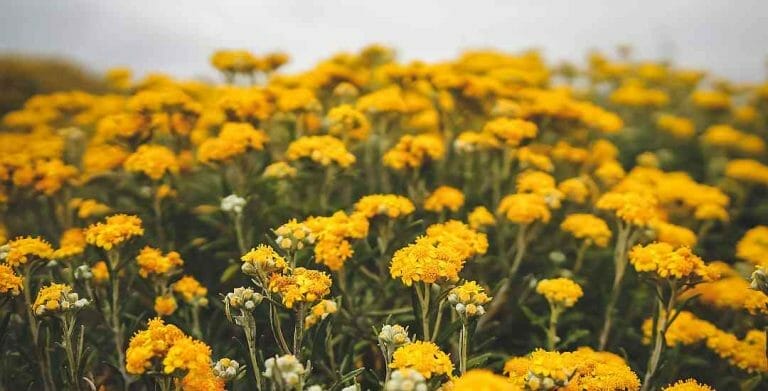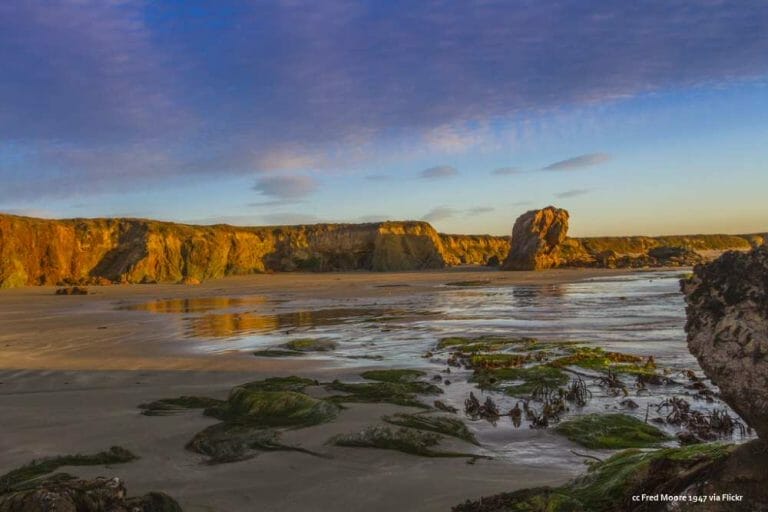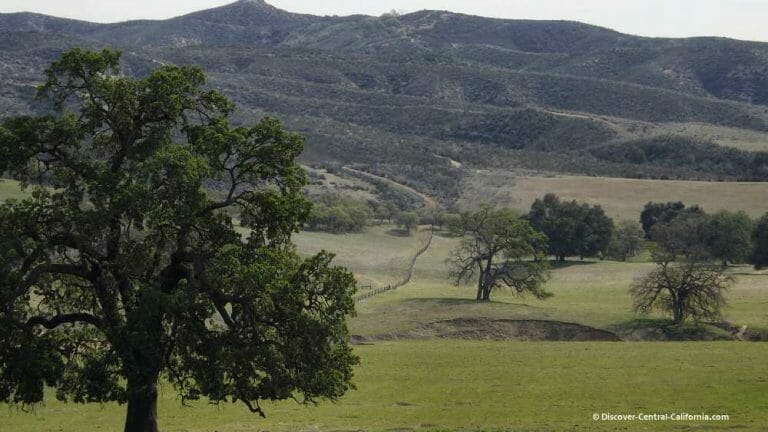Central California Mule Deer

California Mule Deer: (odocoileus hemionus californicus)
California mule deer are an iconic species that represent the rugged beauty of the American West. With their large ears, black-tipped tails, and graceful bounding gaits, mule deer hold a special place in the landscape and lore of California.
The mule deer found in Central California and throughout the West are smaller than the white-tail deer found in the eastern United States.
Their coloring is also different, with a sooty gray or blue gray coat. Central California Mule Deer get their name from the large mule-like ears which are always moving in the attempt to catch the sound of predators.
They can be found nearly everywhere in this region; the real exception being the treeless grasslands at the eastern part of Central California.
As I mentioned in the How to Drive Backroads page, the deer are quite flighty and can jump out in front of your car without you ever having seen them.
They are quite beautiful and if you visit during the late spring or summer, you might also get to see fawns following their mothers. During this time, the mothers group up, with several of them sharing domestic duties among them.
You are far more likely to spot does than bucks, but the bucks are seen from time to time. They will form groups both before and after the mating season (late autumn).
You can sometimes see the deer grazing in fields of barley or alfalfa, but the trees are never far away.
If you wish to photograph any encounters you might have with mule deer along your travels, a good telephoto lens will be required most of the time.
One way to tell the difference between a California Mule Deer and other types of deer is by looking at the antlers. The mule deer’s (and black-tailed deer) antlers grow in an upward direction, whereas other species grow in a forward direction.

Profile of the California Mule Deer
Mule deer are a widespread and highly adaptable species found throughout much of western North America. The subspecies of mule deer that occurs in California is the California mule deer (Odocoileus hemionus californicus).
Compared to other subspecies, the California mule deer tends to be larger in body size with antlers that fork equally or unequally.
Mule deer get their name from their large mule-like ears. Their coats are gray to brown in color with a distinct black-tipped tail. Bucks grow antlers that fork as they mature. The size and number of forks help establish dominance hierarchies among males during the rut. Does are smaller than bucks and do not grow antlers.
They are browsers that typically feed on the leaves, twigs, and shoots of shrubs and trees. However, they diversify their diet with grasses, forbs, berries, acorns, garden plants, and agricultural crops. Their adaptable diet allows them to thrive in a variety of habitats across California.
Where Do Mule Deer Live?
Mule deer are found throughout much of California west of the Sierra Nevada mountains. Their range extends from the Oregon border south along the coast to Baja California, Mexico. They occupy diverse habitats, including chaparral, oak woodlands, coniferous forests, riparian zones, desert scrub, and agricultural areas.
Within their home ranges, mule deer often seek habitat that provides access to food, water, and cover. California mule deer usually browse close to lakes, rivers, or streams that provide their water source.
They will typically make their beds in grassy areas beneath trees within a 100-200 yard radius from both water and forage resources. The beds are simple depressions scratched to a nearly level surface with flattened grass or soil.
While does and fawns use the same beds repeatedly, bucks tend to use different beds each day unless they are rutting.
What Do California Mule Deer Eat?
As browsers, they feed primarily on the leaves, shoots, and twigs of shrubs and trees. Their typical native forage includes species like ceanothus, mountain mahogany, bitterbrush, buckbrush, manzanita, sagebrush, serviceberry, chokecherry, and scrub oak.
During spring and summer, they also consume many types of herbaceous plants, including lupines, iris, clover, vetch, wild oats, and phlox.
Acorns become an important seasonal food source for mule deer when available in fall and early winter. Mule deer diversify their diet with berries, seeds, nuts, buds, mosses, lichens, succulents, mushrooms, and agricultural crops to meet nutritional needs, depending on location and season.
Does and young forage together in familial groupings while bucks tend to travel and feed singly or with other males outside the breeding season. Mule deer often seek shade and rest during the hot midday but become more active at dawn and dusk when they also forage.
Central California mule deer may also forage at night in open agricultural areas or when experiencing hunting pressure. Their adaptable feeding behaviors allow mule deer to thrive across diverse habitats in California.
The Mating Behavior of Mule Deer
Peak of mating activity or rut for mule deer occurs in autumn from October to December. The rut is characterized by increased movement, aggressive behavior in competing for mates, and pronounced necks and body size in bucks. The breeding season and rut last only several days for an individual doe that goes into heat or estrus during this time.
During the rut, a mule deer buck rubs against shrubs and trees with their antlers and creates scrapes on the ground with their hooves to mark territory and attract females. The scrapes and urine then signal breeding condition.

Dominant bucks with the largest antlers do most of the breeding. Younger bucks participate less often in breeding.
The peak of conception is in mid-November, with most fawns born in late May to early June after a 200-day gestation period. Does usually give birth to one to two spotted offspring that weigh 4-8 pounds at birth.
Fawns stay hidden in vegetation for the first couple of weeks until they are strong enough to follow the doe.
The Life Cycle and Growth Stages of Mule Deer
Mule deer young grow rapidly after birth with spots fading during their first summer. The young remain with mothers throughout the summer and are weaned in the autumn at around 4-6 months of age. Buck fawns begin to grow their first set of single-pointed antlers soon after weaning.
The antlers grow during spring and summer before hardening into true antlers by late summer. In early winter each year, the previous season’s antlers are shed and a new set grows once more in spring in anticipation of the next breeding season.
The cycle repeats annually, though they become larger and more branched as a buck matures.
Mule deer does start breeding in their second year with peak reproduction from 3 to 10 years of age. The average lifespan in the wild is 10 years, though deer may live into their late teens and even early 20s in ideal conditions with low predation. Hunting pressures often reduce lifespan for bucks in particular.

The Habits and Behaviors of Central California Mule Deer
They are generally crepuscular, meaning most active at dawn and dusk, though they adjust activity patterns to avoid heat and hunting pressures. Bucks are more solitary while does and their offspring form groupings, especially during summer. When foraging, deer remain alert with excellent vision, hearing, and sense of smell to detect predators.
At the first sign of danger, mule deer bound away with their distinctive rocking gait, reaching speeds over 35 miles per hour. They also rely on camouflage and hiding instincts when threatened.
Mule deer are strong swimmers, and their height allows them to move through deep snow. During cold weather, they conserve energy by restricting movement to smaller home ranges.
In warmer seasons, home ranges overlap more fluidly. Some populations migrate seasonally between higher summer and lower winter ranges. Migration routes can span over 150 miles round trip each year. Fawns learn the seasonal migration patterns from mothers during their first year.
Pronking
An interesting behavior to watch for is a gait they use when fleeing a perceived danger – they will bounce along on all four legs with all feet touching and leaving the ground simultaneously. Several quadrupeds use this and it is called either pronking or stotting.
How Do Mule Deer Impact Ecosystems?
As abundant native herbivores, mule deer influence vegetation growth, composition, and regeneration. Selective feeding and antler rubbing shapes plant communities over time. Predator-prey relationships with mountain lions, coyotes, bobcats, and others also structure ecosystems and food webs.
By dispersing seeds in feces and fur, deer facilitate plant regeneration across their range. As prey species, deer also subsidize large carnivores, including endangered species like California condors that scavenge deer carcasses.
Overall, mule deer play diverse ecological roles throughout California ecosystems as browsers, prey, seed dispersers, and drivers of trophic cascades.

Modern Challenges Facing California Mule Deer
Major challenges facing mule deer today include:
Habitat loss and fragmentation from urbanization, roads, energy development, and other land use changes. Deer rely on migratory corridors and habitat connectivity.
Increased vehicular collisions as roads and traffic expand into deer habitat. Over 20,000 deer are hit by vehicles annually in California.
Introduced and invasive plant species that reduce native browse and forage quality. Cheatgrass and medusahead invade grasslands, displacing native plants.
Disease outbreaks, including chronic wasting disease, adenovirus hemorrhagic disease, and bluetongue virus, periodically impact local populations.
Predation pressures from native and introduced predators that limit fawn recruitment and survival. Coyotes, bobcats, and mountain lions prey on deer.
Droughts that reduce habitat productivity and quality. Lack of rain and snowpack decreases forage.
Climate change that alters seasonal patterns, migration, reproduction, and vulnerability to disease.
Wildfires that destroy habitat and food source. Increased fires burn across deer habitat. Fire suppression also degrades habitat over time.
Hunting pressures that skew sex ratios if not properly managed. Overhunting of bucks impacts herd demographics.
Addressing these threats through science-based habitat management and conservation policy is crucial for sustaining resilient mule deer populations into the future.
Conservation Status and Management of Mule Deer
The California Department of Fish and Wildlife monitors mule deer populations and sets regional hunting regulations to manage herds sustainably. Conservation efforts also focus on protecting and restoring habitat connectivity through wildlife corridors and reducing vehicular collisions along roadways.
While mule deer still number around 450,000 statewide, populations in some regions have declined 50-75% in recent decades. However, investments in research, habitat improvements, highway crossings, and conservation policy offer promise for stabilizing and recovering mule deer numbers across their California range.
Overall, the mule deer remains a vitally important species ecologically, economically, and culturally. As a treasured game animal and living symbol of the American West, conserving the mule deer and its habitat will ensure future generations can experience the beauty and grace of this iconic deer species bounding across California’s wild landscapes.
Key Takeaways
The California mule deer is a widespread species adapted to diverse western habitats from deserts to forests.
Mule deer rely on shrubbery, trees, grasses, and forbs for food while needing access to water sources.
Seasonal migration between summer and winter range is a key survival strategy.
Antler growth and the autumn rut are driven by hormones and signaling reproductive condition.
Conservation threats include habitat loss and fragmentation, vehicular collisions, wildfires, disease, and climate change.
Managing resilient deer herds in California depends on science-based habitat protections and sustainable hunting practices.
Frequently Asked Questions
How fast can a mule deer run?
Mule deer can reach top speeds over 35 miles per hour and cruise at speeds of 15-25 mph. Their bounding leaps can span over 8 feet in a single jump.
What time of day are mule deer most active?
Mule deer are generally crepuscular, meaning most active at dusk and dawn, though they adjust activity patterns to avoid heat and hunting pressures.
How long do mule deer live?
Average lifespan is 10 years, though deer may live into their late teens and early 20s in ideal conditions with low predation. Lifespans are often shorter for bucks.
How many fawns do mule deer have?
The average is 1-2 offspring per doe after a 200-day gestation. Does start breeding at age two and reach peak reproduction from 3 to 10 years old.
How can you tell a mule deer gender?
Adult males or bucks grow antlers annually while females or does do not. Buck fawns also have button antlers. Body size is also larger in bucks.
What eats mule deer?
Major predators include cougars, coyotes, bobcats, bears, and golden eagles. Mules deer’s young are vulnerable to foxes, hawks, and owls. Humans also hunt mule deer.
What time of year do mule deer mate?
Mating or rutting season peaks from October to December in most locations with fawns born in late spring after a 200-day pregnancy.
How often do mule deer migrate?
In migratory populations, mule deer make seasonal migrations of 150 miles or more between summer and winter ranges each year.
Why are mule deer important?
As abundant native browsers, mule deer help shape plant communities. They act as prey for large carnivores and disperse seeds vital for regeneration.
How can we conserve mule deer?
Protecting migration corridors, reducing collisions, managing habitat, controlling invasive species, balancing hunting, and mitigating climate impacts through policy and planning.
Conclusion
Whether you’re a longtime local or visiting Central California for the first time, keep your eyes peeled for our iconic mule deer! If you’re lucky enough to spot these graceful animals, it’s a sight you won’t soon forget.
Watching a doe lead her fawns through dappled sunlight or seeing a buck’s antlers silhouetted against an evening sky is a special privilege. The mule deer’s beauty and charisma inspire a sense of wonder in all of us.
Seeing them pronk across a hillside with all four feet leaving the ground is an amazing experience.
The mule deer is a living symbol of the rugged landscapes that make Central California so special. We’re fortunate to share the land with these iconic deer.






